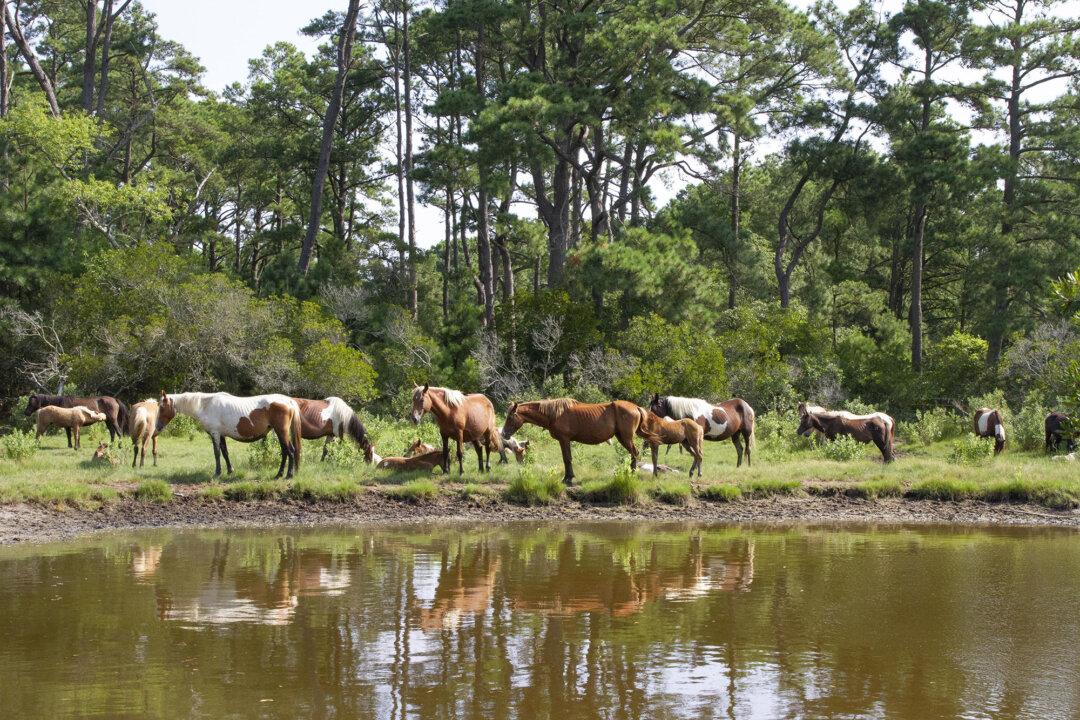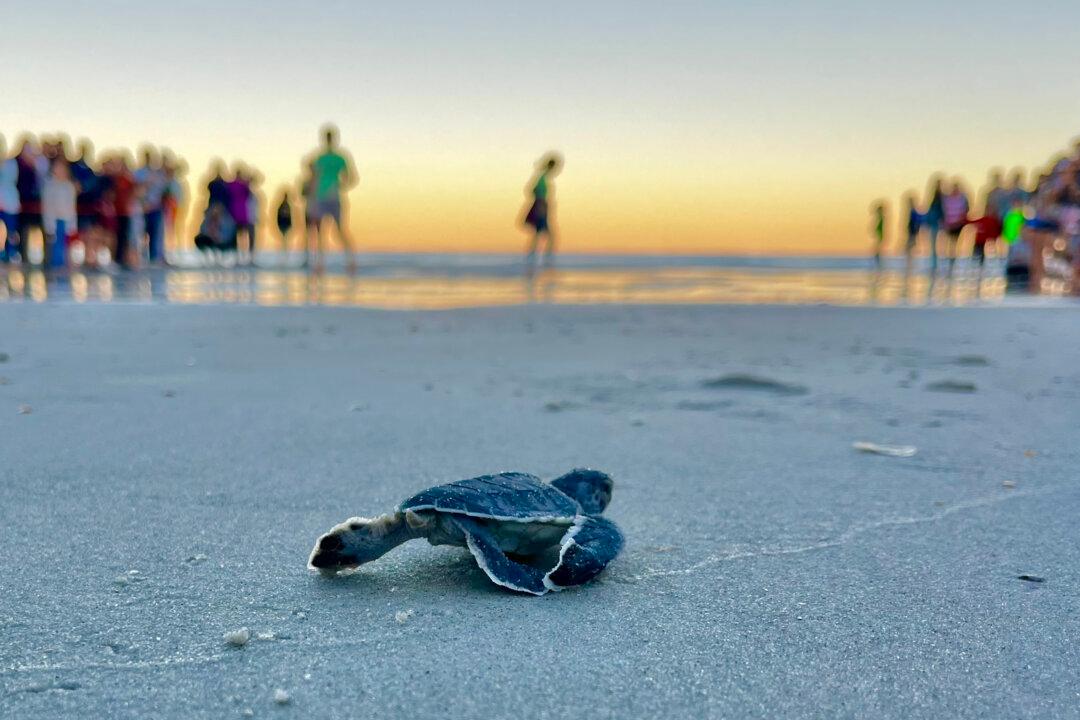Florida’s manatees gently glide through the state’s rivers and along coastal beaches like great grey footballs, endearing themselves to residents and tourists alike.
The half-ton whiskery mammals are celebrated throughout the state on T-shirts, license plates, and with huggable stuffed toys in their likeness.
Tourists and locals converge on inland waterways during winter, donning dive gear and plunging into chilly waters when manatees migrate inland in massive numbers each year.
Enraptured humans hope simply to snap photos of the sea cows moving through the water lazily with curious calves. The peaceful animals exude an aura of complete contentedness, seemingly unafraid.
But now, when ocean temperatures dip below 68 degrees, waterways on the state’s Atlantic coast have become nightmarish for the thousands of manatees seeking refuge from the cold there.
Long their winter sanctuary, the coastline has become a place of starvation.
As of Jan. 28, 97 manatees had died this year, with 64 in Brevard County, the epicenter of the starvation crisis. During the same 28-day period at the beginning of last year, 170 manatees perished.

But that’s probably because January this year was mostly warm. It’s the cold that complicates matters for manatees, and as temperatures dip, wildlife authorities predict deaths will go up. By how many, they can’t say.
Last year, more than 1,100 manatees died. That’s about 13 percent of the manatee population. The animals had spent 50 years on the endangered species list and were only recently reclassified as threatened in 2017.
So understandably, Floridians’ hearts are breaking over a crisis that has the beloved animals dying in record numbers along the coastline.
The cause: the obliteration of their food source. Seagrasses in areas where many seek warmth in winter have been wiped out by water pollution.
For now, there’s no end to the crisis in sight, government wildlife authorities say. To look for solutions, a partnership was formed in 2021 between the Florida Fish and Wildlife Conservation Commission (FWC) and the U.S. Fish and Wildlife Service (USFWS). They’re working together now to combat what they’re calling an Unusual Mortality Event (UME).
Since coming together to solve the problem, the agencies have navigated mostly discouraging reports on the situation.
In recent days, scientists working on a short-term fix rejoiced about a major breakthrough.
In mid-January, researchers decided to take desperate measures that go against the first rule in dealing with wildlife. They started trying to feed the wild manatees.
More bad news followed. About two weeks into the team effort involving state and federal authorities and wildlife-related nonprofits, the project looked to be a failure. The manatees are used to nibbling on slim delicately undulating seagrasses underwater and don’t recognize floating heads of lettuce as food.
But in the last days of January, as forecasts predicted deadly cold, workers tossing romaine and butterhead bunches to the starving animals saw what looked like a miracle.
Manatees were munching.
More good news followed. As they’d hoped once a few of the hungry herbivores recognized broad, bright-green, lettuce leaves as food, others began eagerly chomping too. Soon, clusters of manatees clamored for a taste, poking their noses to the surface to gobble the floating vegetation.
Now, trucks hauling lettuce are delivering about 2,500 pounds daily to an area set up for feeding the animals at a Florida Power and Light natural gas power plant in Brevard County. The area is off-limits to spectators and boaters as scientists work as fast as they can to stabilize the health of as many animals as possible.
On the chilliest recent days, up to 750 animals bunched into the site. It isn’t clear exactly how many are eating and how much they’re getting, authorities told reporters on Feb. 2 in a video conference.
A healthy adult manatee needs to eat about 4 to 9 percent of its body weight per day. That’s 40 to 90 pounds of vegetation.

But the successful feeding program is a cause for hope. And scientists say they’re thankful to be learning lessons that will help them feed wild manatees next winter too. It’s almost certain the remaining population will need the help, authorities say.
Efforts to replant seagrass beds that would sustain the remaining manatee population naturally have begun. But there are significant obstacles, authorities say. They expect progress will be slow. They’re not sure how long it will take to regrow the seagrasses needed, FWC spokeswoman Carli Segelson said.
Permits must be obtained, so other agencies can be sure the efforts won’t cause other problems while attempting to solve this one.
Donor seagrass beds are practically nonexistent in places where harvest could be practical, authorities told reporters. So seagrasses now are being grown for transplant in upland nurseries.
And the need to improve water quality so that newly started seagrass beds can grow and flourish is a problem that has no easy answer, authorities admit. But part of the plan involves restoring clam and oyster beds. Those creatures naturally filter the water around them.
The vexing seagrass die-off began due to pollution from the run-off of yard fertilizer, sewage, pet waste, and other sources. As nutrients from those pollutants streamed into waterways, algae growth exploded.
Algae clouds the water, blocking sunlight. Without sunlight, seagrasses die.
Most animals simply move on when their habitat runs out of food. Not manatees.
Water temperatures colder than 68 degrees make them sick. Their bulbous bodies aren’t covered in insulating blubber to protect them against cold. Most of an adult manatee’s 10-foot-long frame is muscle.
So as coastal waters chill, manatees seek spring-fed waterways that stay 72 degrees year-round, or they find their way to areas where power plants supply heated discharge from cooling towers.
There are about 67 sites, natural and manmade, where manatees find warmth around the state. They often visit the same places year after year.

About half the population has become reliant on power plant discharge canals, authorities say. But as power production decreases, less warm water flows into waterways where manatees have come to expect relief.
Thousands of manatees are drawn each year to what used to be a safe harbor for them within the Indian River Lagoon, a 156-mile biodiverse habitat along Florida’s East Coast. About 4,400 plant and animal species live there.
Though seagrasses have been in decline there since 2011, the migratory manatees kept coming, and eating, until there was nothing left for them. Now, unable to leave the area because of deadly-cold water temperatures beyond the lagoon, the animals are stuck there with nothing to eat.
Necropsies reveal many of the starving animals have resorted to ingesting sand off the seafloor in an attempt to survive. Many of the dead are lactating mothers who have higher calorie demands while nursing their calves for a year.
That has left orphans. Some of these babies, along with adult animals spotted in the worst condition, are being rescued and transported to a network of facilities willing to take in manatees for rehabilitation. The hope is to make them well enough for eventual release where there’s warm water and more food. That’s often on the state’s western side, bordered by the Gulf of Mexico.
Keepers at ZooTampa at Lowry Park, SeaWorld, and others have been treating and releasing manatees for decades. Boat strikes used to be the most common reason animals needed their help.

In the first four weeks of this year, 14 manatees were rescued and transported to rehab facilities. As of the first week in February, about a dozen more had been spotted in need of rescue, authorities said.
But rescue efforts are difficult, especially on days when chilly temperatures cause animals to congregate in clusters. The hope is to attempt rescues of those in the most distress at the first sign of warmer weather, authorities said.
Biologists understand how heart-wrenching the problem is for Floridians, who love their state’s iconic creature. But taking matters into their own hands and throwing food to the animals could make matters worse. It also happens to be against the law, one that authorities won’t hesitate to prosecute.
The reason is that trying to feed wild manatees or offer them drinks from a hose—something the animals seem to enjoy—may encourage them to stay year-round in waterways that can’t provide enough food or warmth for them, researchers say. During the team’s feedings, workers hide behind screens so the animals won’t associate the suddenly appearing food with humans.
The best way for Floridians to help manatees is to report distressed, dead, or tagged animals by calling the state wildlife hotline at 888-404-3922 (FWCC). Manatees in distress may seem to come up for air too frequently or may list to one side while swimming.
Having a photo or video of suspicious manatee behavior that can be sent to the hotline operator can help.
Teams try to remove all manatee carcasses because those aren’t good for waterways either.

Possibly the biggest heartbreak of all, say members of three wildlife organizations, is that the manatee starvation problem didn’t have to happen. It was totally preventable, they say.
Wildlife advocates pointed out the need to take action to protect manatee habitat in 2008, during the George W. Bush administration.
A year into the presidency of Barack Obama, the agency finally acknowledged the need to take action, but nothing was ever done, says Jaclyn Lopez of the Center for Biological Diversity.
Her group, along with Defenders of Wildlife and the Save the Manatee Club, filed a lawsuit on Feb. 1 against the U.S. Fish and Wildlife Service. The lawsuit says the agency didn’t follow the law requiring administrators to designate protected habitats for manatees.
“The lawsuit is directed to the federal agency, and as a matter of policy, the USFWS does not comment on ongoing litigation,” Chuck Underwood, a spokesman for the agency, told The Epoch Times.
The saddest part is that the animals’ suffering and the potential loss of the species could have been avoided altogether, Lopez says.
Government scientists don’t believe the problem will lead to extinction or even near-extinction, Segelson told The Epoch Times.
By fall, federal authorities are likely to decide whether to officially change the designation of the West Indian manatee—the official name of the Florida species—back to endangered, Segelson said.

Lopez says government scientists long “have known this ecosystem was in collapse,” and had seagrass been listed as an element needing to be monitored, as the groups had suggested 14 years ago, “perhaps the [U.S. Environmental Protection Agency] would have realized much earlier that the water-quality standards it approved for the [Indian River Lagoon] were inadequate to protect manatees and their habitat.”
The Center for Biological Diversity is a national nonprofit conservation organization with more than 1.7 million members and online activists dedicated to the protection of endangered species and wild places.
The Save the Manatee Club has advocated for manatees since 1981 through scientific research, education, public awareness, and legislative action. Defenders of Wildlife has nearly 2.2 million members and activists focused on protecting all native plants and animals and their habitats.
“In the broadest sense,” Lopez said, the problem was “totally preventable—in that we should be able to stop pollution at its source, detect when waters become polluted, and take swift action to improve water quality.
“In a nutshell, USFWS should have long ago revised critical habitat to include things like seagrass. That way, when other federal agencies authorize a project that might impact habitat, FWS could have looked at EPA’s proposal and made a decision as to whether it would destroy the habitat, which is unlawful and would require modifications of the project.”
Lopez and her colleagues hope aggressive moves to improve water quality and regrow seagrass beds can turn the problem around in time to save the manatees.
“It is possible,” she says, “but I don’t know whether it will be done.”





